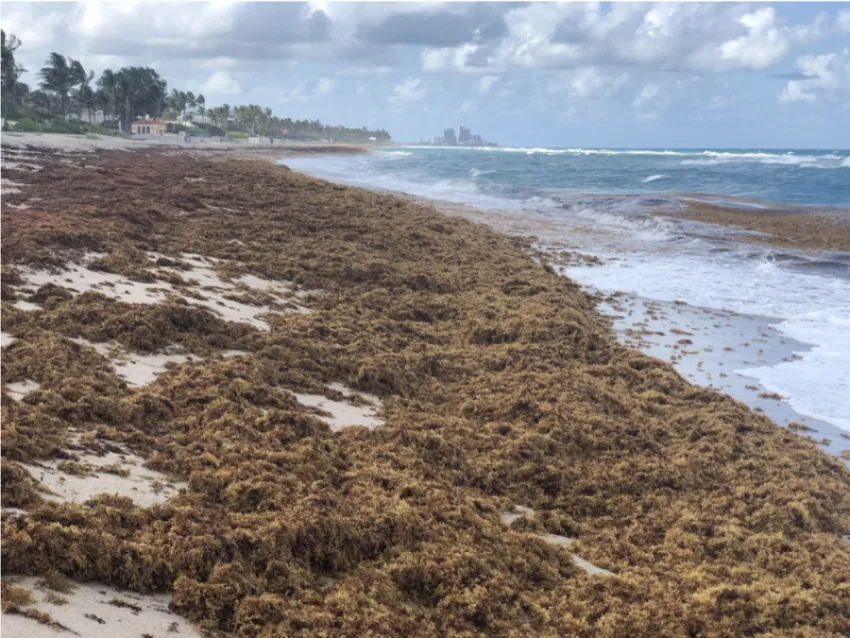
8,000-km seaweed patch is heading to popular beaches ahead of tourist season
The patch could pose a risk to tourism in several countries.
The world's largest seaweed patch is headed toward popular beaches just ahead of tourist season.
The right combination of wind and currents can push it ashore. It is currently moving westward, where it could potentially inundate beaches along the Florida Keys, throughout Mexico's Yucatán Peninsula, and in eastern portions of the Caribbean.
It has already started washing up in chunks of Florida beaches, the National Post reports. An estimated 10 tons have surfaced on the Yucatán Peninsula, creating piles almost a metre high.
SEE ALSO: Global algae blooms are growing, and warming waters may be to blame, study says
It's called the great Atlantic sargassum belt - a mass that scientists have been tracking since 2011. Today, it spans 8,000 km and stretches from western Africa all the way toward the Gulf of Mexico. If the sight of it isn't enough to keep tourists away, its scent likely will. As it starts to decompose it smells like rotten eggs.
And then there's the toxic effects. It has created health issues due to exposure to hydrogen sulphide gas, and it's arsenic.
Last year's bloom caused a headache for officials in Barbados, who required 1,600 dump trucks a day to remove the seaweed and keep the beaches usable, NPR reports.
What is sargassum?
Sargassum is leafy, rootless, and buoyant algae that collect and float through the ocean.
Out in the open, it soaks up carbon dioxide and provides a habitat for several bird, mollusk, and turtle species.
Closer to shore, though, it can disrupt local ecosystems and the economy by smothering coral, keeping tourists away, and reducing fishing yields.
2011 is when scientists noted a change in the patches. That's when they started to grow, reaching sizes observed by satellites.

The Great Atlantic Sargassum Belt in July 2018, as seen by NASA’s Moderate Resolution Imaging Spectroradiometer (MODIS) on Terra and Aqua satellites. Data provided by Mengqiu Wang and Chuanmin Hu, USF College of Marine Science (NASA/Earth Observatory)
As for what caused the bloom to balloon, scientists aren't sure - but there could be a few factors at play.
Brian LaPointe, a research professor at Florida Atlantic University's Harbor Branch Oceanographic Institute, tells The Weather Network that unusual North Atlantic oscillation in 2010 pushed the seaweed towards Africa, where it picked up nutrients that helped it grow in the Congo River.
In the Amazon basin, the bloom picked up nitrogen and phosphorus, present in the water due to deforestation burns and population growth nearby.

The clumps of sodden seaweed can emit a foul smell (Brian LaPointe/Submitted)
"So that that bloom looks like it continues to grow as it moves from the African coast...and continues to grow right up through the Caribbean region into the Gulf of Mexico," he says.
"You have the Orinoco River, you've got the Mississippi River. We have a lot of evidence that nitrogen coming down the Mississippi River is feeding it."
While the size fluctuates, it generally reaches its largest during the summer.
The current patch doubled in size every month between November and January, according to The University of South Florida's Optical Oceanography Lab, which uses NASA satellite imagery to track the bloom. It did, however, slightly decrease in size in February.
The seaweed chain, which weighs about 13 million tons, should reach peak bloom in July. The highest patch ever recorded was 22 million tons in 2018.
Canadian east coast beaches are not at risk, but if you plan on traveling to places like Florida or the Caribbean this spring and summer, you may find yourself in a sticky situation as officials grapple with a way to mitigate the problem.
"We really have not found a silver bullet to solve this problem entirely...I think one of the more promising solutions is sinking the sargassum at sea," LaPointe says, describing a process that involves collecting the seaweed in large nets and towing it out to pump it down into the ocean depths.
"There are a number of projects underway right now that are doing this in the Dominican Republic and Antigua."
RELATED: 'Red tide' kills fish in Florida
Thumbnail credit: Brian LaPointe/Submitted.











